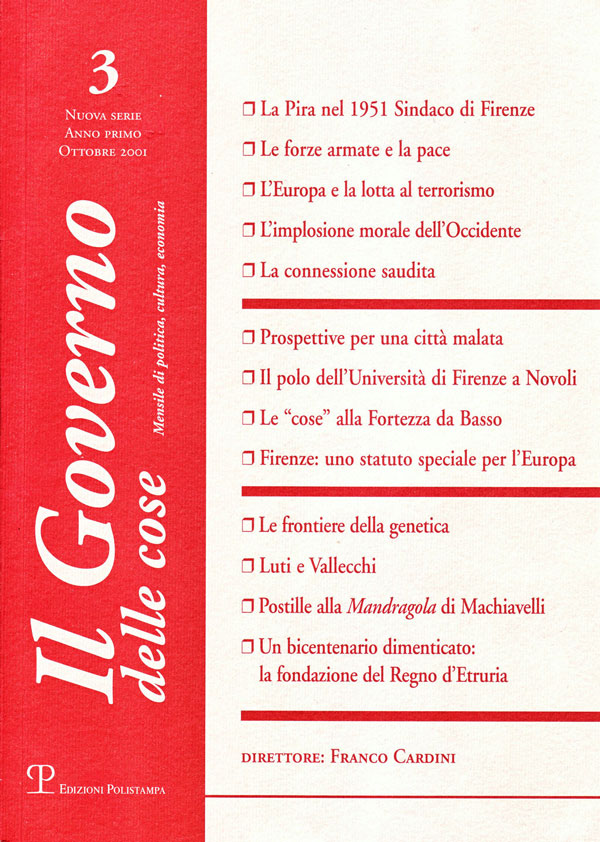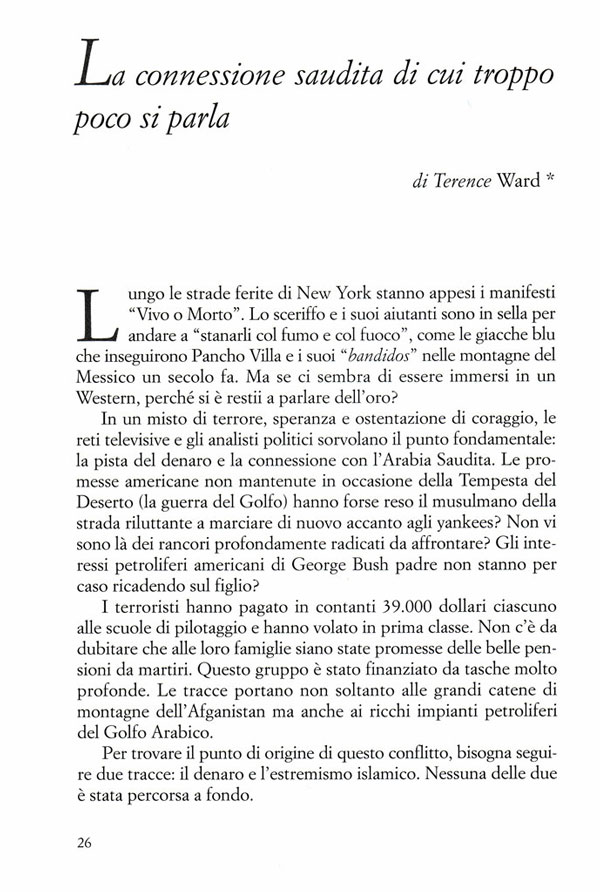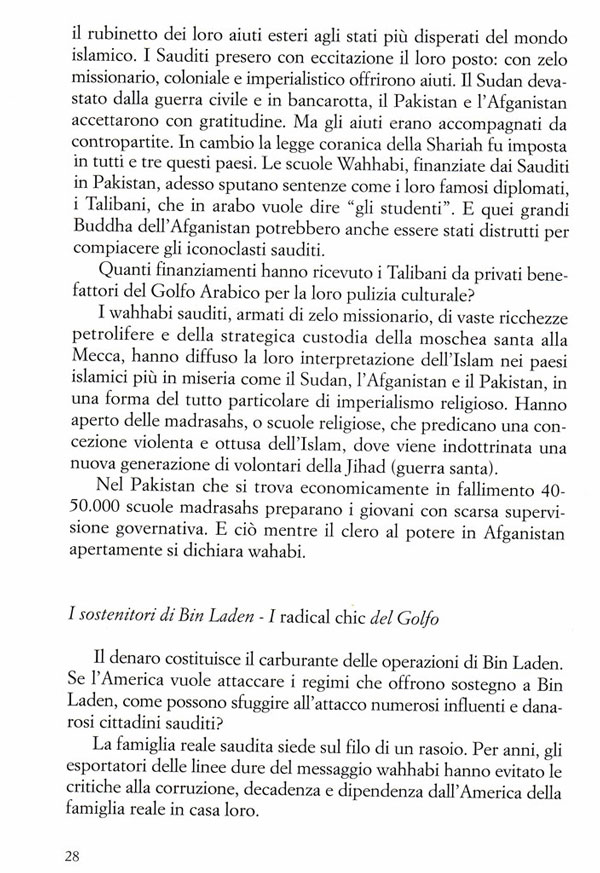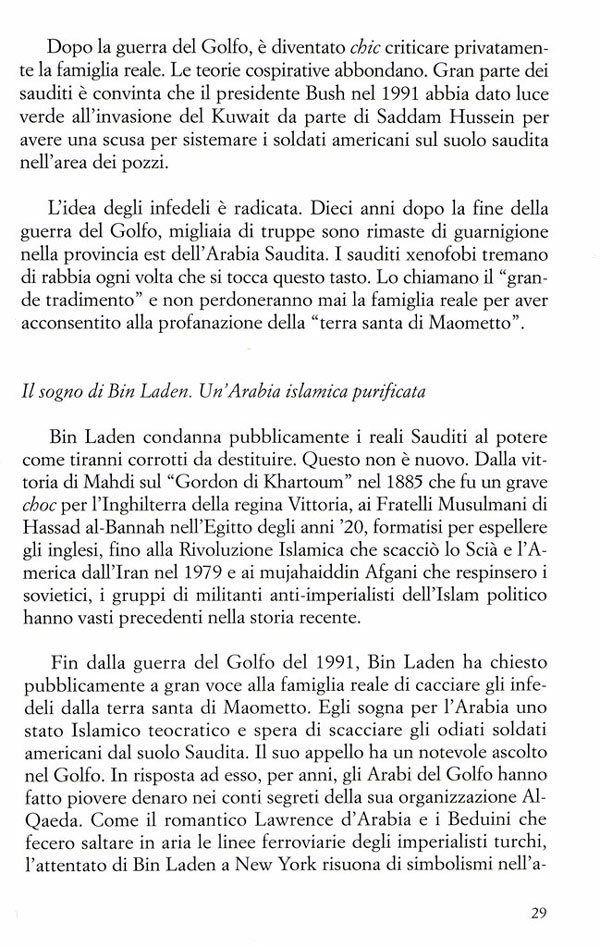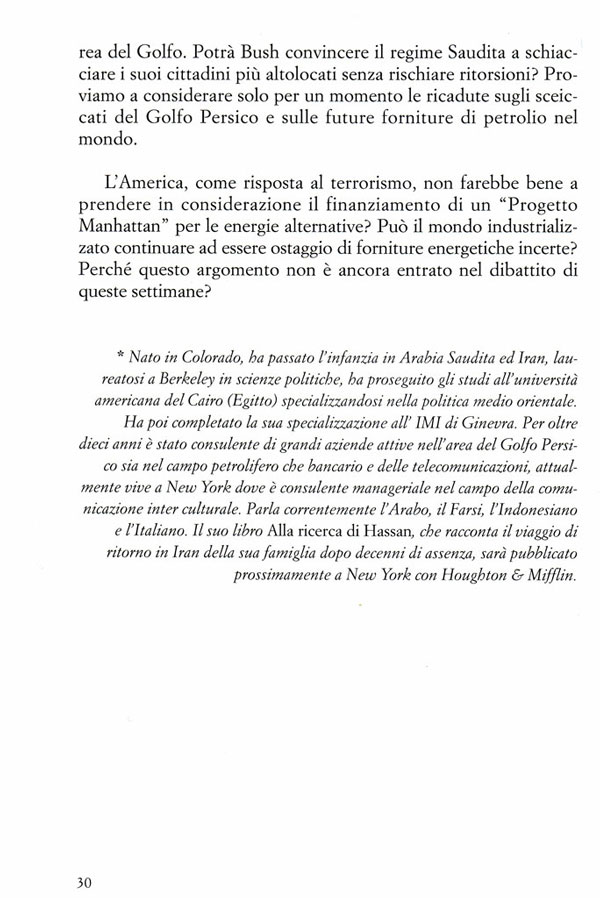Along the wounded streets of New York, posters scream “Dead or Alive.” The sheriff and his deputies are “geared up to smoke ’em out,” like the bluecoats who chased Pancho Villa and his bandidos across the mountains of Mexico a century ago. But if we are all immersed in a Western film, why does no one speak of the gold? In this mist of terror, hope, and dramatic courage, television news broadcasters and political analysts avoid the fundamental point: the money trail leads to Saudi Arabia.
Did failed American promises after “Desert Storm,” the first Gulf War, spark the “Arab street” to launch a new attack on the Yankees? Have the American oil interests of George Bush’s father come back to haunt his son?
The terrorists paid in cash $39,000 to attend a flight school and only flew in first class. No doubt, their families were promised fine pensions for their martyrdom. Clearly, this group is financed by very deep pockets. The tracks do not lead only to the mountain caves Afghanistan but also to the rich oil installations in Gulf.
To comprehend the origin of this conflict, we have to follow two paths. One into an extremist Islamic sect, the other to its funding. Neither has been pursued until now. Yet, it is clear the share the same source: Saudi Arabia.
Not so strangely, the long-standing Bush/Cheney petroleum connection has left out of the official investigation their long-standing patron–oil-rich Saudi Arabia and its puritannical xenophobic Wahhabi. But, in fact, the money trail leads directly to Saudi Arabia and the Gulf. It is from there that sympathetic millionaires have financed Bin Laden and the Islamic schools throughout the Muslim world–especially in dirt-poor Pakistan and Afghanistan. And slowly, during this man-hunt, Americans will discover that the majority of the attackers had Saudi connections: citizenship, addresses, false documents and passports. Why?
The Wahhabis of Saudi Arabia
For thirty years, the Wahhabi religious sect diffused its puritan message into the Islamic World. This militant sect was born in the sands of Arabia during the first decade of 1800, founded by a charasmatic leader, Abdel Wahhab. His call to purify Islam sparked the Bedouins to rise up and throw the foreign Ottoman Turks out of Mecca.
Later in 1932, the sect became the state religion of Saudi Arabia under Abdul Aziz, the founder of the Saud dynasty. It carries a distinctly different message than the cosmopolitan, tolerant and multi-ethnic faith that flourished during the Golden Age of Islam of the Abassid Caliphate. The Wahhabi sect of today in Saudi Arabia is a virulently fundamentalist doctrine, riddled with prejudice, claims of religious purity, and obsessed with its relentless campaign of misogony against Muslim women.
In a few words, they are the “Mormons” and the “Hassidics” of the Muslim World. In fact, the Wahhabis consider most of their muslim brothers in the Middle East, apostates and heretics; just as the ultra-orthodox fanatics condemn reformist Jews in Israel. For Wahhabis, any muslim nation not governed by the Shariah, Islamic law, remains inhabited with fallen believers and sinners. Their most bitter enemies are not Israel, but Iranian Shiites whom they often call shaton or “devils.” For this reason, don’t expect Iran to become drawn into this conflict. The Shiites detest the Wahhabis of Saudi Arabia and Afghanistan.
Money, markets and military power have long governed political geography. In the Middle East, this has been the rule. Ironically, decades ago when the US closed off its faucet of foreign aid to failed states in the Islamic world, the Saudis stepped into the gap to assume that role with enthusiasm. Armed with an imperial plan and missionary zeal, Saudis offered their aid.
Sudan and Afghanistan, devastated from civil wars, accepted with gratitude. Pakistan did the same. But, this aid came with strings attached. In exchange, Koranic Shariah law was imposed in all three countries. Wahhabi-funded religious schools called madrasahs across Pakistan would produce the “Taliban” which in Arabic means “the students.” Even, the destruction of Bamiyam’s great Buddhas statues was a gift to please the iconoclast Saudis. A question remains–how much did the Taliban leaders receive from private benefactors in the Gulf for this cultural cleansing?
The Saudi Wahhabis, iinfused with missionary zeal, vast oil riches and the strategic custodianship of the sacred mosque in Mecca, have diffused their unique interpretation of Islam across the most impoverished muslim countries on earth–in Sudan, Pakistan and Afghanistan. It is a potent form of religious imperialism. And its impact, we will witness for years to come. Religious schools preaching a violent form of Islam have indoctrinated a new generation of Jihad volunteers. Today, in bankrupt Pakistan, over 40,000 madrasahs prepare the young with little government supervision. And clerics openly occupy seats of power declaring themselves to be Wahhabis.
Radical Chic in the Gulf – Supporters of Bin Laden
Money fuels Bin Laden’s operations. If America wants to attack regimes that offer shelter to him, how can numerous influential and wealthy Saudi citizens escape this coming vendetta? The Saud royal family sits on a razor’s edge. For years, exporters of the hard-line Wahhabi message have long considered the Sauds tainted by corruption, decadence, and, most importantly, American dependence.
After the Gulf War, it became chic to privately criticize the royal family. Conspiracy theories abounded. Most Saudis were convinced that President Bush in 1991 gave the green light to Saddam’s invasion of Kuwait so that US soldiers could then secure and occupy the Saudi oil fields.
Among Saudis, the idea of “infidel troops” is rooted in reality. Ten years after the end of the Gulf War, thousands of US soldiers still remained guarding the Eastern Province of Saudi Arabia. Xenophobic Saudis tremble with rage each time that this subject is raised. They call it the “great betrayal” and will never forgive the Royal Family for accepting this desecration on the “land of two holy mosques.”
Bin Laden’s Dream — a Purified Islamic Arabia
Bin Laden has publicly condemned the Saudi Royals as corrupt tyrants to be dethroned. But, his call to the faithful is not new. One simply needs to listen to the historic voices of the past. Islamic anti-imperialists echo across over the last century.
The victorious Mahdi in Sudan swept aside “Gordon of Khartoum” in 1885 stunning Queen Victoria’s Britain; in Egypt, Hassan al-Bannah led the Muslim Brotherhood in riots to expel English colonials during 1930’s; in Iran, Ayatollah Khomeini’s voice spearheaded the Islamic Revolution that hurled out the Shah and his America backers in 1979; and the tenacious Mujahaddin funded by Saudi and America finally drove the occupying atheist Soviets out of Afghanistan in 1988. This long parade of political Islam has strong precedence. Bin Laden was never speaking in a vaccuum. Surely, Western advisors and analysts should have been aware of this reality.
The crucial moment when Saddam’s armies stood poised at the Saudi frontier, Bin Laden pleaded with King Fahad to entrust him and his victorious Afghan forces to defend the homeland. The King rejected his offer, choosing American military protection instead. After the Gulf War ended in 1991, Bin Laden then boldly demanded that the Saud Family order the foreign infidels out of the “Holy Land of the Prophet” once and for all. No one in the regime heeded his call.
The attacks of September 2001 are rooted in this two-fold rejection. US forces stayed. Bin Laden rebelled. The rest is history. Recently, he articulated his dream–a new Arabian Caliphate, free of loathed US soldiers and decadent Royals. To drive the point home, he attacked the regime’s closest ally. America’s most powerful city may be mortally scarred. But his true target was the Royals in Riyadh.
Like the romantic Lawrence of Arabia and his Bedouins who blew up the Hejaz railroad line of the imperialist Turks in 1918, this attack resounded echoed across the Gulf like a warning bell. Many have heard his message clearly. So, why do American policy-makers not yet understand this crucial linkage? And how can Bush convince the Saudi regime to pursue its own citizens who funded this attack?
After pondering the roots of these terrorist acts, wouldn’t America be better served to consider funding a Project Manhattan for alternative energy? How can the industrial world remain hostage such a uncertain source of energy? Why hasn’t this argument been raised in the halls of power during these last desperate weeks?
Born in Colorado, he spent his childhood in Arabia and Iran, graduated from Bekeley in political science and studied in the American University in Cairo specializing in Middle Eastern politics, before completing his specialization at IMI Geneva. for 10 years he consulted for major firms of the Persian Gulf in petroleum, finance and telecommunication. He now lives in New York where he is a management consultant in inter-cultural communication. he speaks Arabic, Farsi, Indonesian and Italian. His book Searching for Hassan–a chronicle of his voyage back to Iran with his family after twenty years–will be published in New York by Houghton & Mifflin

